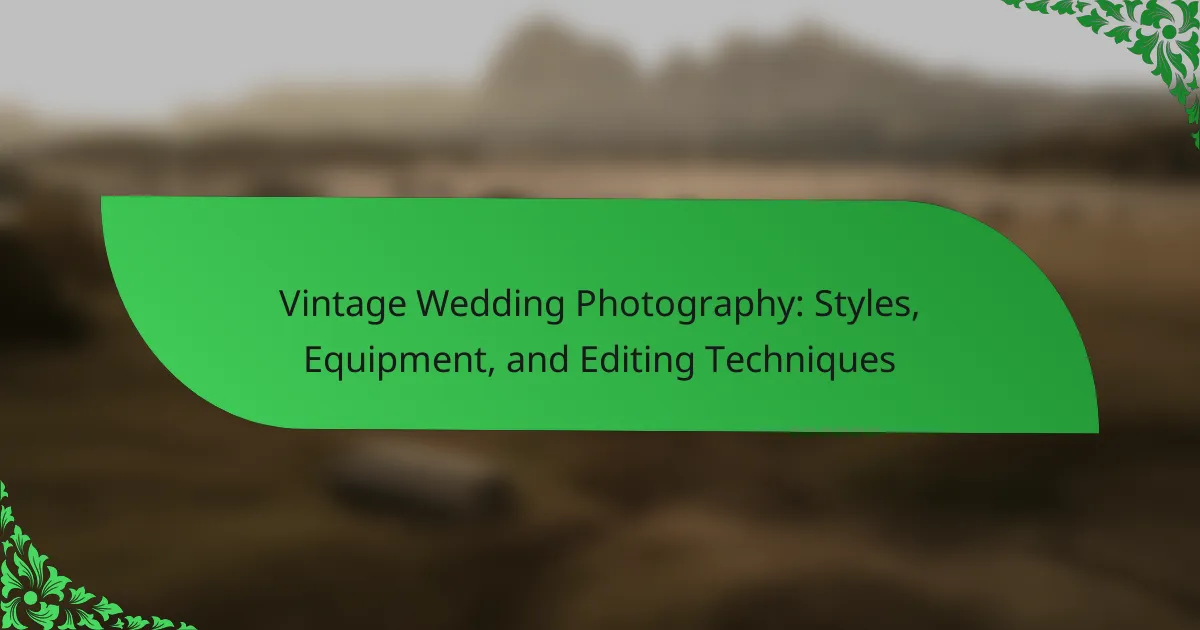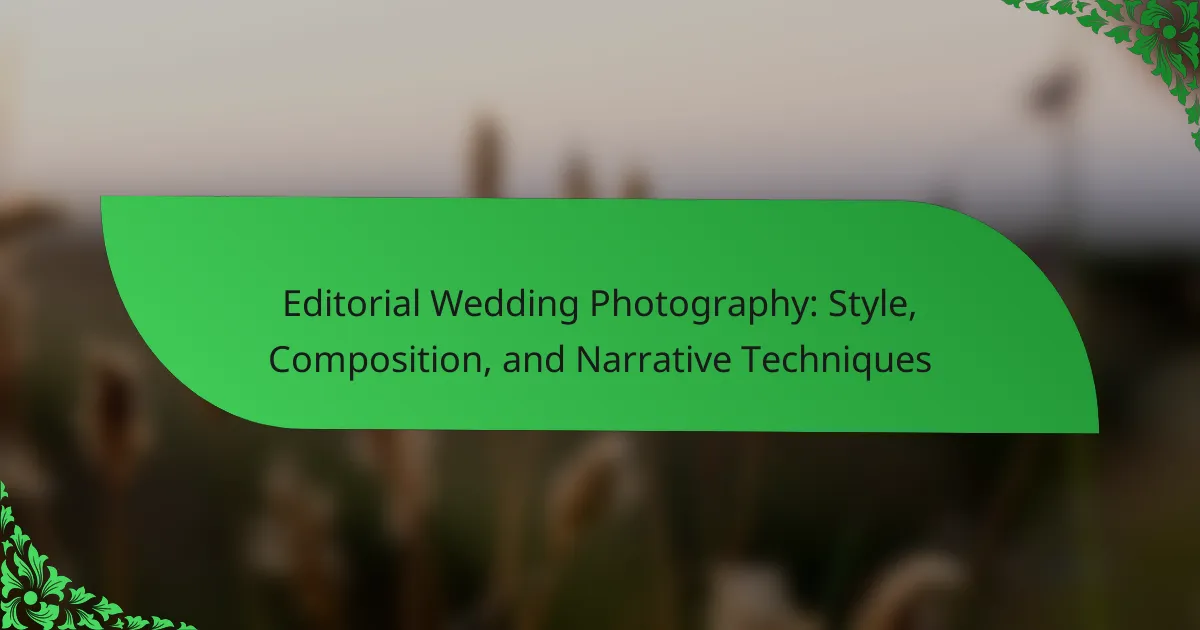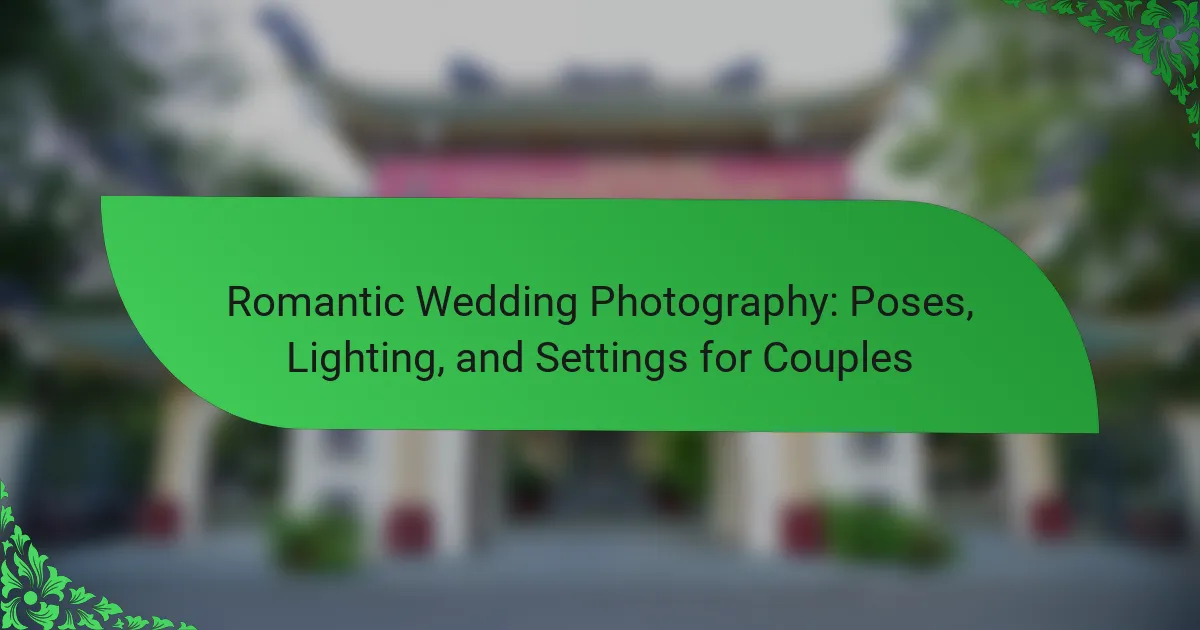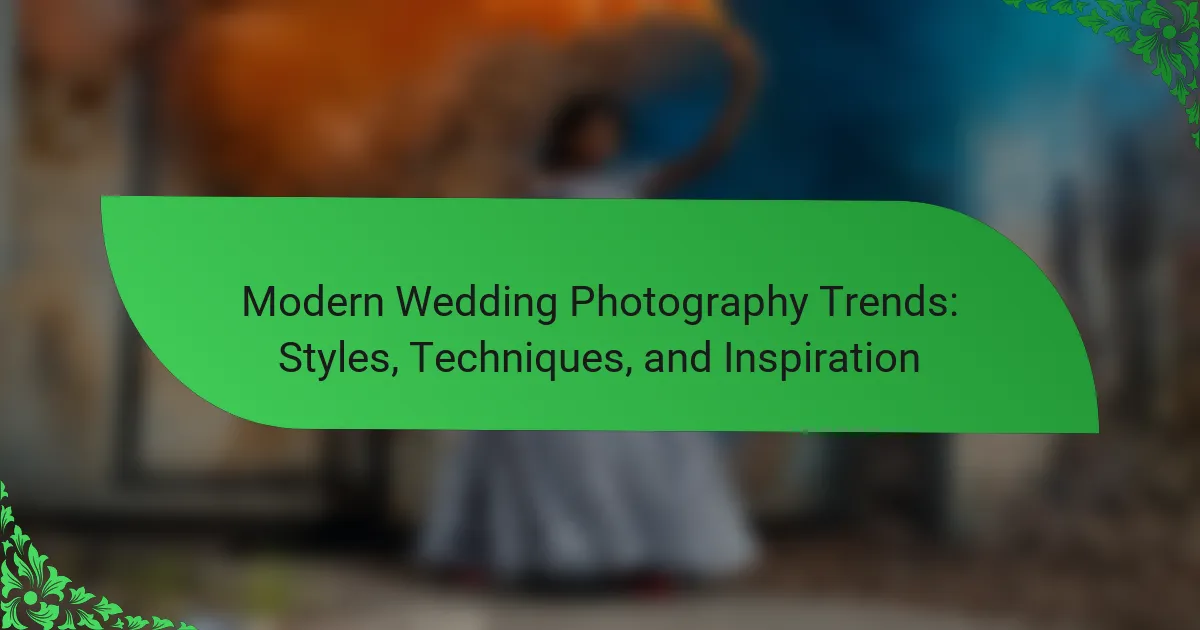Vintage wedding photography is a style characterized by a nostalgic and timeless aesthetic, often utilizing techniques from the early to mid-20th century. Key elements include soft focus, muted colors, and grainy textures, achieved through the use of vintage cameras or specific editing styles. Essential equipment for this photography style includes DSLR or mirrorless cameras with manual settings, prime lenses, tripods, and light meters. Common editing techniques involve sepia toning, grain addition, and color desaturation to create a romantic and classic feel. This article explores the various styles, necessary equipment, and editing techniques that define vintage wedding photography.
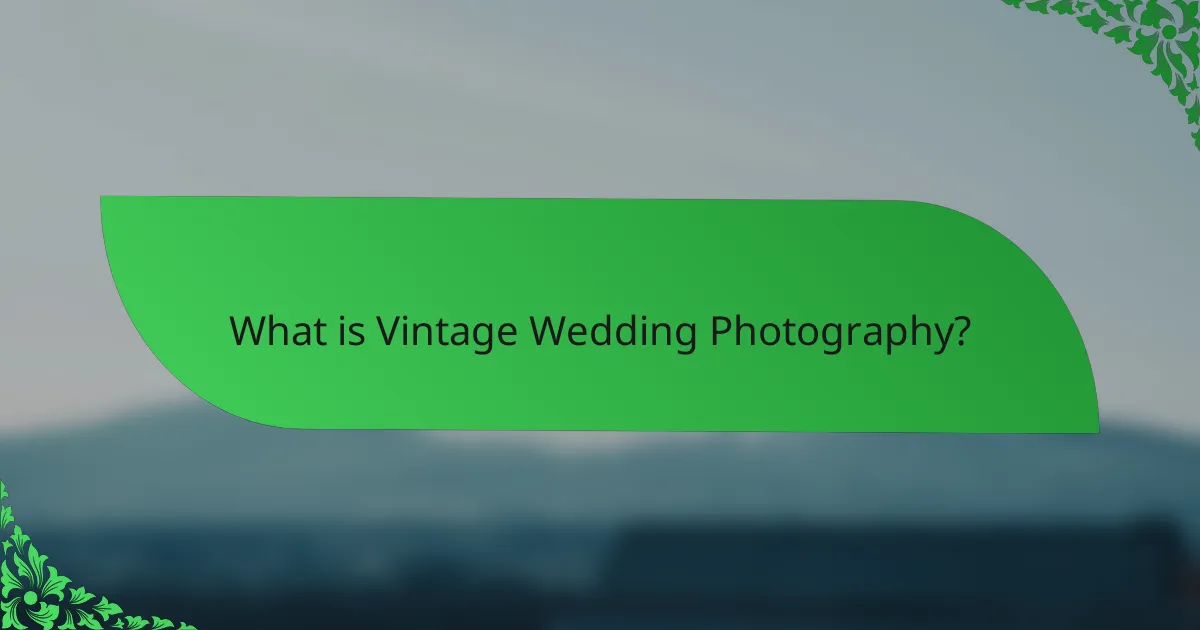
What is Vintage Wedding Photography?
Vintage wedding photography is a style that captures weddings with a nostalgic and timeless aesthetic. This approach often employs techniques reminiscent of photography from the early to mid-20th century. Common characteristics include soft focus, muted colors, and grainy textures. Photographers may use vintage cameras or editing styles to achieve these effects. The goal is to evoke emotions and memories associated with past eras. Many couples choose this style for its romantic and classic feel. Vintage photography often includes candid shots and posed portraits that reflect the couple’s personality. This style has gained popularity for its unique charm and artistic expression.
How does Vintage Wedding Photography differ from modern styles?
Vintage Wedding Photography captures moments with a nostalgic aesthetic, differing from modern styles in technique and presentation. Vintage photography often employs soft focus, muted colors, and grainy textures to evoke a timeless feel. In contrast, modern styles utilize sharp focus, vibrant colors, and clean lines for a contemporary look. Vintage photographers might favor film cameras or post-processing techniques that mimic film effects. Modern photographers typically rely on digital cameras with high resolution and advanced editing software. The choice of lighting also varies; vintage styles often use natural or soft lighting, while modern styles may incorporate artificial lighting for dramatic effects. These distinctions highlight the contrasting approaches to storytelling and emotion in wedding photography.
What are the key characteristics of Vintage Wedding Photography?
Vintage Wedding Photography is characterized by its nostalgic aesthetic and timeless appeal. This style often employs soft focus and natural lighting to create a romantic atmosphere. Film grain and faded colors are commonly used to evoke a sense of history. Additionally, vintage wedding photography often incorporates classic poses and candid moments that reflect the couple’s genuine emotions. Props and settings that resemble past eras enhance the overall vintage feel. The use of antique or retro equipment is also a hallmark, contributing to the unique texture of the images. Overall, these characteristics work together to capture the essence of love in a bygone era.
Why is nostalgia important in Vintage Wedding Photography?
Nostalgia is important in vintage wedding photography because it evokes emotions and memories from the past. This style captures timeless moments that resonate with couples and their families. Vintage aesthetics often include sepia tones and soft focus, enhancing the nostalgic feel. Such elements create a connection to cherished memories and traditions. Research shows that nostalgia can increase feelings of happiness and belonging. By incorporating nostalgic elements, photographers can create a more meaningful experience for clients. This approach often leads to a deeper emotional response from viewers. Ultimately, nostalgia enriches the storytelling aspect of wedding photography.
What are the different styles of Vintage Wedding Photography?
The different styles of Vintage Wedding Photography include Classic, Film Noir, and Bohemian. Classic vintage photography emphasizes timeless elegance and soft color palettes. Film Noir style incorporates dramatic lighting and shadows for a moody atmosphere. Bohemian vintage photography focuses on natural settings and candid moments, often featuring earthy tones. Each style evokes a distinct nostalgic feel, appealing to couples seeking a romantic aesthetic. These styles draw inspiration from various historical periods, enhancing their authenticity.
How do various eras influence Vintage Wedding Photography styles?
Various eras significantly influence Vintage Wedding Photography styles through distinct aesthetic preferences and technological advancements. For example, the Victorian era emphasized formal poses and elaborate backdrops. This era’s photography often featured sepia tones and intricate framing. The 1920s introduced a more relaxed approach, showcasing candid moments and flapper fashion. This period favored black and white photography with a focus on spontaneity. The 1970s embraced vibrant colors and bohemian styles, reflecting the cultural shifts of the time. This era often used natural light and outdoor settings to enhance authenticity. Each era’s unique characteristics shape the visual narrative captured in vintage wedding photography.
What are some popular themes in Vintage Wedding Photography?
Some popular themes in Vintage Wedding Photography include rustic, bohemian, and classic elegance. Rustic themes often feature natural settings and earthy tones. Bohemian themes incorporate free-spirited elements and eclectic decor. Classic elegance focuses on timeless styles and traditional attire. These themes evoke nostalgia and capture the essence of past eras. Vintage photography often uses soft focus and warm tones to enhance the aesthetic. Additionally, props like lace, antique furniture, and vintage cars are commonly used. These elements create a romantic and timeless atmosphere for wedding photography.
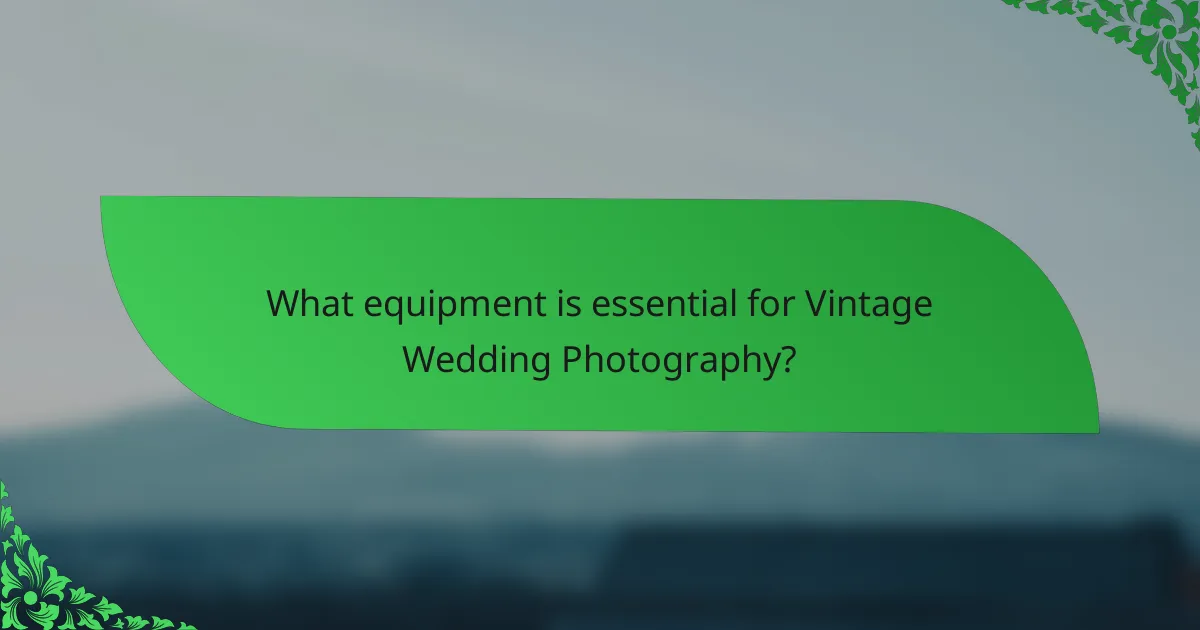
What equipment is essential for Vintage Wedding Photography?
Essential equipment for Vintage Wedding Photography includes a DSLR or mirrorless camera. A camera with manual settings allows for creative control over exposure and focus. Prime lenses, particularly 50mm or 85mm, are ideal for capturing portraits with a vintage feel. A tripod ensures stability for long exposure shots, especially in low light. Vintage lenses can add authentic character to the images. Light meters help achieve accurate exposure in varying lighting conditions. Lastly, editing software is crucial for achieving the desired vintage aesthetic in post-processing.
What types of cameras are best for achieving a vintage look?
Film cameras are best for achieving a vintage look. They produce softer images with unique grain patterns. Popular options include 35mm cameras like the Canon AE-1 and Nikon FM2. Medium format cameras like the Hasselblad 500C also provide a distinct aesthetic. Instant cameras, such as the Polaroid SX-70, create authentic vintage prints. These cameras often have character that digital cameras lack. Their mechanical nature contributes to the nostalgic feel. Additionally, using vintage lenses on modern cameras can replicate the vintage effect.
How do film cameras compare to digital cameras in Vintage Wedding Photography?
Film cameras offer a distinct aesthetic compared to digital cameras in vintage wedding photography. Film produces a softer, more organic look due to its grain structure. This quality often evokes nostalgia, aligning well with vintage themes. Digital cameras provide high-resolution images with greater detail and clarity. However, they can sometimes appear too sharp or clinical for vintage styles.
Film has a dynamic range that captures highlights and shadows in a unique way. This characteristic can enhance the romantic feel of wedding photos. Digital cameras allow immediate feedback and editing flexibility, which can be beneficial for capturing spontaneous moments.
In terms of workflow, film requires developing and scanning, which can take longer than the instant results from digital cameras. Many photographers appreciate the ritual of film processing, adding to the vintage experience. Ultimately, the choice between film and digital depends on the desired aesthetic and shooting style.
What lenses are recommended for capturing vintage-style images?
Prime lenses and vintage lenses are recommended for capturing vintage-style images. Prime lenses like 50mm f/1.8 or 85mm f/1.8 provide sharpness and a shallow depth of field. Vintage lenses, such as Helios 44-2 or Canon FD series, offer unique bokeh and character. These lenses often produce soft focus and subtle color shifts. Their optical characteristics emulate film photography aesthetics. Using these lenses can enhance the nostalgic feel of images. Many photographers prefer manual focus to achieve precise control. This approach aligns with the vintage photography style.
What accessories enhance Vintage Wedding Photography?
Accessories that enhance vintage wedding photography include props, lighting tools, and camera filters. Vintage props like antique furniture, lace, and old books create a nostalgic atmosphere. Soft lighting, such as fairy lights or vintage lamps, adds warmth and charm to photos. Camera filters, particularly sepia or soft-focus filters, help achieve a timeless look. Vintage lenses can also contribute unique bokeh effects. These accessories collectively help capture the essence of vintage aesthetics in wedding photography.
How do lighting tools affect the vintage aesthetic?
Lighting tools significantly influence the vintage aesthetic in photography. They create mood and enhance the nostalgic feel of images. Soft, diffused light mimics the look of older film photography. This type of lighting can evoke warmth and intimacy. Additionally, colored gels can replicate vintage film tones. Using backlighting can add a dreamy quality to portraits. Low-light conditions can also enhance shadow play, contributing to a classic look. These techniques align with historical photography styles, reinforcing the vintage theme.
What role do props play in Vintage Wedding Photography?
Props play a significant role in Vintage Wedding Photography by enhancing the overall aesthetic and storytelling. They help create a nostalgic atmosphere that aligns with vintage themes. Common props include antique furniture, vintage suitcases, and old cameras. These items evoke a sense of history and charm. They also provide context and depth to the photographs. Using props can help couples express their personalities and styles. Additionally, props can serve as focal points in compositions. They contribute to the narrative, making images more engaging and memorable.
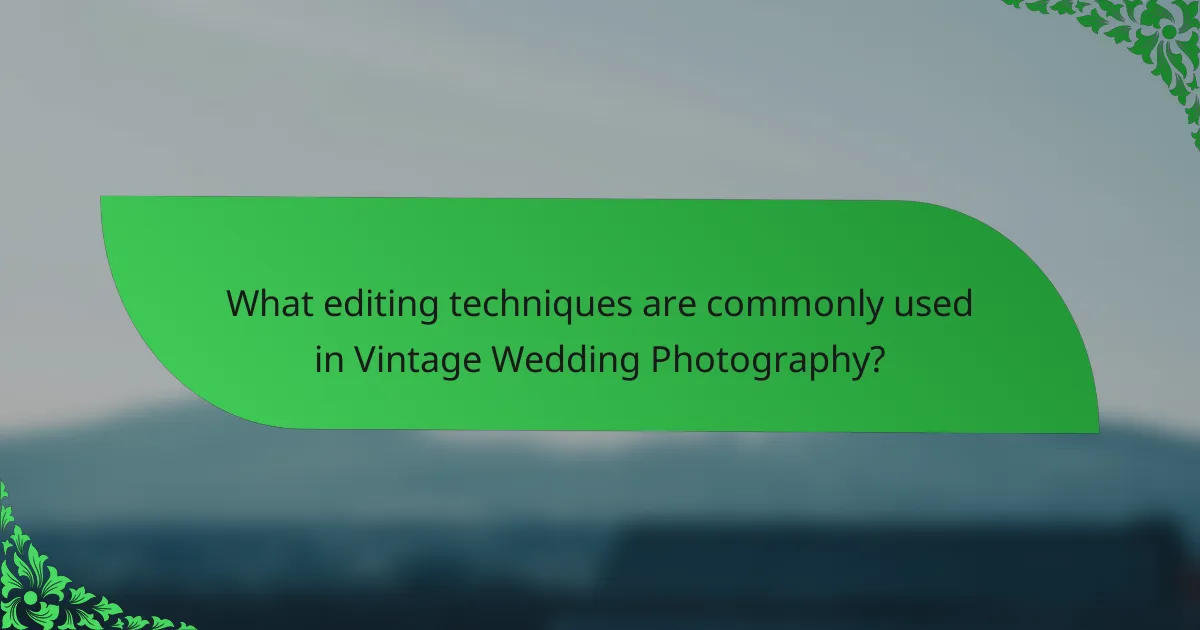
What editing techniques are commonly used in Vintage Wedding Photography?
Common editing techniques used in vintage wedding photography include sepia toning, grain addition, and color desaturation. Sepia toning gives images a warm, nostalgic look reminiscent of old photographs. Grain addition mimics the texture of film, enhancing the vintage feel. Color desaturation reduces the vibrancy of colors, creating a softer, timeless appearance. Additionally, light leaks and vignetting are often applied to evoke a sense of nostalgia. These techniques collectively contribute to the overall aesthetic that characterizes vintage wedding photography.
How does post-processing contribute to the vintage effect?
Post-processing significantly contributes to the vintage effect by altering colors and textures. It often involves desaturating colors to create a muted palette. This mimics the look of older film photography. Additionally, adding grain can replicate the texture of vintage film. Adjusting contrast enhances shadows and highlights, giving images depth. Applying vignetting draws focus to the center, a common trait in vintage photos. Filters can simulate light leaks or fading, further enhancing the nostalgic feel. These techniques collectively create a timeless aesthetic associated with vintage photography.
What software is preferred for editing Vintage Wedding photos?
Adobe Lightroom is preferred for editing vintage wedding photos. It offers powerful tools for color grading and exposure adjustments. Lightroom’s presets allow for quick application of vintage styles. Another popular choice is Adobe Photoshop, which provides advanced editing capabilities. Photoshop enables detailed retouching and layer management. Both software options are widely used in the photography industry. They help achieve the desired vintage aesthetic effectively.
What specific editing techniques create a vintage feel?
Specific editing techniques that create a vintage feel include desaturation, film grain addition, and color tinting. Desaturation reduces the vibrancy of colors, mimicking older photography styles. Film grain addition replicates the texture of vintage film, enhancing the nostalgic appearance. Color tinting, such as applying sepia or muted tones, evokes a historical aesthetic. These techniques collectively contribute to a timeless quality in images.
What are the best practices for editing Vintage Wedding Photography?
Best practices for editing Vintage Wedding Photography include using a soft color palette and adding grain for authenticity. Adjusting exposure and contrast can enhance the nostalgic feel. Using vignettes can draw attention to the couple. Incorporating faded tones mimics older film styles. Applying a subtle blur can soften sharp images. Cropping to classic aspect ratios adds to the vintage aesthetic. Finally, utilizing presets designed for vintage looks streamlines the editing process. These techniques collectively evoke the charm of historical photography.
How can photographers maintain consistency in vintage editing?
Photographers can maintain consistency in vintage editing by using preset filters and color grading techniques. These tools help achieve a uniform look across images. Consistent use of specific color palettes is crucial. Photographers should select a limited range of tones that evoke a vintage feel. Additionally, applying similar grain effects can enhance the retro aesthetic. Regularly reviewing past edits ensures adherence to the established style. Utilizing software with batch processing capabilities aids in maintaining uniformity. Finally, documenting the editing process creates a reference for future projects.
What common mistakes should be avoided in editing vintage photos?
Common mistakes to avoid in editing vintage photos include over-saturation of colors. Vintage photos typically have muted tones. Excessive brightness can wash out details. Increasing contrast too much can lead to loss of shadow detail. Applying modern filters may disrupt the authentic vintage look. Cropping too aggressively can remove important elements. Neglecting to preserve grain can make the photo appear too digital. Lastly, failing to maintain consistency with a series can lead to a disjointed collection.
What tips can help photographers excel in Vintage Wedding Photography?
To excel in Vintage Wedding Photography, photographers should focus on mastering specific techniques. Understanding vintage aesthetics is crucial. This includes studying historical photography styles and color palettes. Utilizing natural light enhances the nostalgic feel. Photographers should also consider using vintage lenses for authentic results. Incorporating props and settings that reflect the era adds character. Editing with film emulation software can recreate vintage looks. Finally, communicating with clients about their vision is essential for capturing their unique story.
Vintage Wedding Photography is a nostalgic style that captures weddings with a timeless aesthetic, characterized by soft focus, muted colors, and grainy textures. This article explores various aspects of vintage wedding photography, including its distinct styles such as Classic, Film Noir, and Bohemian, as well as essential equipment like film cameras and prime lenses. It also discusses key editing techniques that contribute to the vintage effect, such as sepia toning and grain addition, while providing best practices for maintaining consistency in editing. Overall, the article offers a comprehensive overview of how to effectively capture and edit vintage wedding photographs, appealing to couples seeking a romantic and classic feel for their special day.
